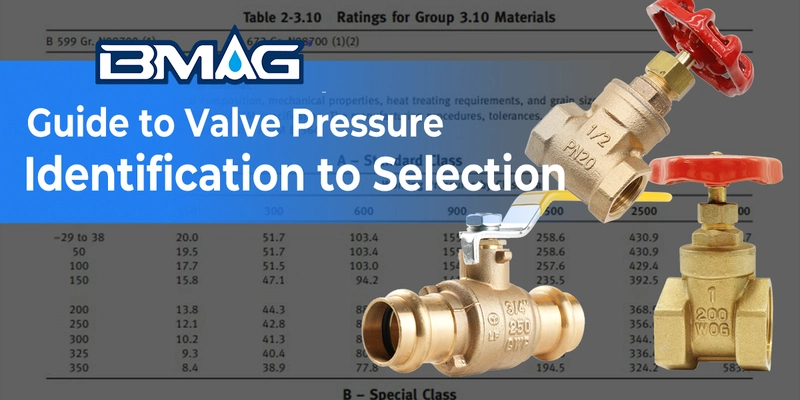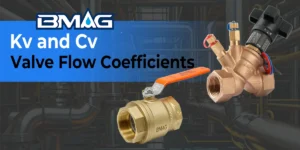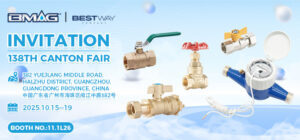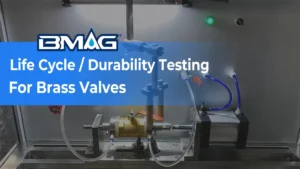バルブは、流体制御システムに不可欠なコアコンポーネントです, 正しいことを正しく理解し、選択します バルブ圧力 評価は、システム全体の安全性と安定性を確保するための基本です. 誤った選択は、バルブの漏れにつながる可能性があります, ダメージ, または深刻な安全事故でさえ. このガイドは、バルブ圧力に関するすべての重要な質問に体系的に答えるための権威あるリソースとして機能します.
目次
トグルバルブ圧力とは何ですか?
バルブ圧力とは、バルブが特定の温度で耐えることができる最大許容圧力を指します. この概念は通常、2つのレベルで理解されます:
- 公称圧力 (pn): これは、設計に使用される参照値です, 製造, およびアプリケーション, バルブの全体的な圧力能力を表す. 通常、によって識別されます “pn” 標準化されたシリーズです. 同じ作業圧力がすべての温度で維持できるという意味ではありません.
- 作業圧力: これは、バルブが特定の動作温度で実際のアプリケーションで影響を受ける実際の流体圧です. 作業圧力は、常にその温度でのバルブの最大許容圧力以下でなければなりません.

バルブ圧力とは何ですか?
a バルブの圧力定格 特定の標準に従ってバルブの圧力処理機能を分類する標準化された分類システムです (asmeのように, で, API).
異なるバルブ圧力評価の概念と用語
- 公称圧力 (pn): 欧州標準システム (で 1092-1), バーに基づいています, バルブの機械的強度に関連する一連の参照番号です.
- クラス評価 (ポンド): アメリカの標準システム (ASME B16.34, B16.5) 圧力に基づいた一連のクラスは、さまざまな温度で耐えることができます. これは、理解するための鍵です バルブの圧力評価の意味, それは本質的に温度にリンクされているためです. すべてのタイプ, aから ゲートバルブの圧力定格 に ボールバルブの圧力定格, このシステムに従ってください.
- API圧力評価: アメリカ石油研究所 (API) 石油およびガス産業の圧力評価を確立します, のような 2000, 3000, 5000, 10000 API 6aのpsi, 作業圧力評価が定義されています.
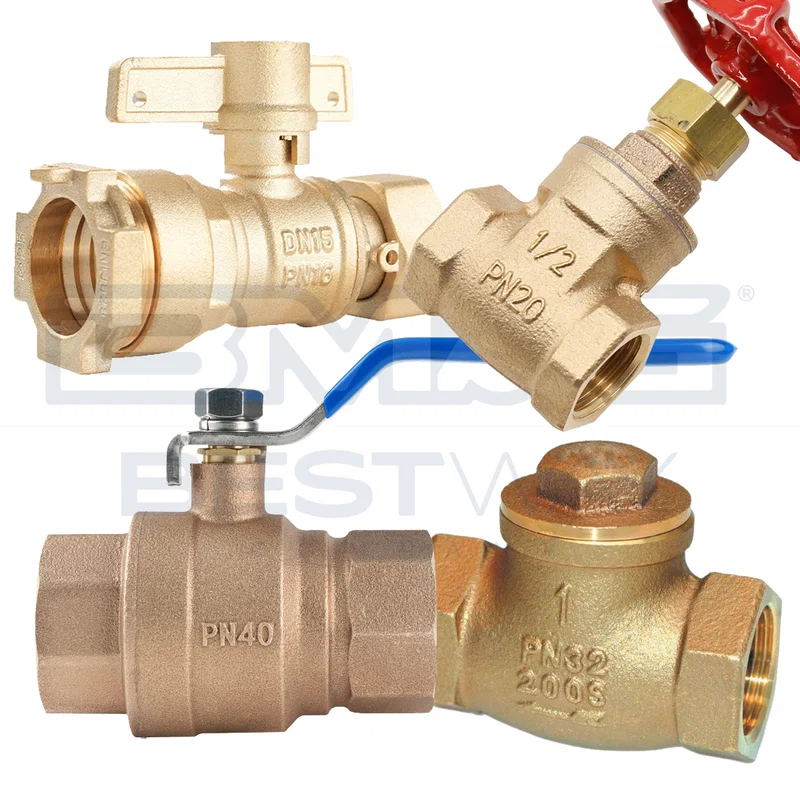
バルブ圧力の単位は何ですか?
- バー: バルブ圧力の一般的な国際単位. 1 バー≈ 1 雰囲気.
- MPA (メガパスカル): ユニットの国際バルブシステムの一次圧力ユニット (そして). 1 MPA = 1,000,000 PA.
- psi (平方インチあたりのポンド): インペリアルバルブユニット, 北米では非常に一般的です.
- kgf/cm² (平方センチあたりキログラムフォース): 技術的な雰囲気ユニット.
バルブ本体の圧力マーキングを識別する方法?
バルブ本体に鋳造または刻印されたマーキングは、その圧力能力を識別する最も直接的な方法です. 一般的なマーキングには含まれます:
- PN評価: 例えば。, PN16, PN25, PN40. これは、バーのバルブの公称圧力を示し、ヨーロッパのコア識別子であることを示しています (で) 標準システム.
- クラス (またはポンド評価): 例えば。, 150ポンド, クラス 150, 300ポンド. これは、アメリカ人の圧力評価識別子です (ASME) 標準システム. 数値はPSIに直接対応していません. クラス 150 バルブは、処理できるという意味ではありません 150 psi; その特定の機能は、対応する圧力温度評価チャートから決定する必要があります.
- 計量 / CWP: 例えば。, 600 計量 または 1000 CWP.
- 計量 水を表します, 油, ガス.
- CWP 冷たい作業圧力を表します.
- 計量 / CWP 主に交換可能であり、バルブが周囲温度で処理できる最大圧力を示しています (通常、-20°F〜100°Fまたは-29°C〜38°C) 水のため, 油, ガスメディア. 例えば, a 真鍮ボールバルブの圧力評価 の “800 計量” 安全に処理できることを意味します 800 寒さの下でpsi, 非ショック条件.
クラスごとの作業圧力– ASME B16.34-2004
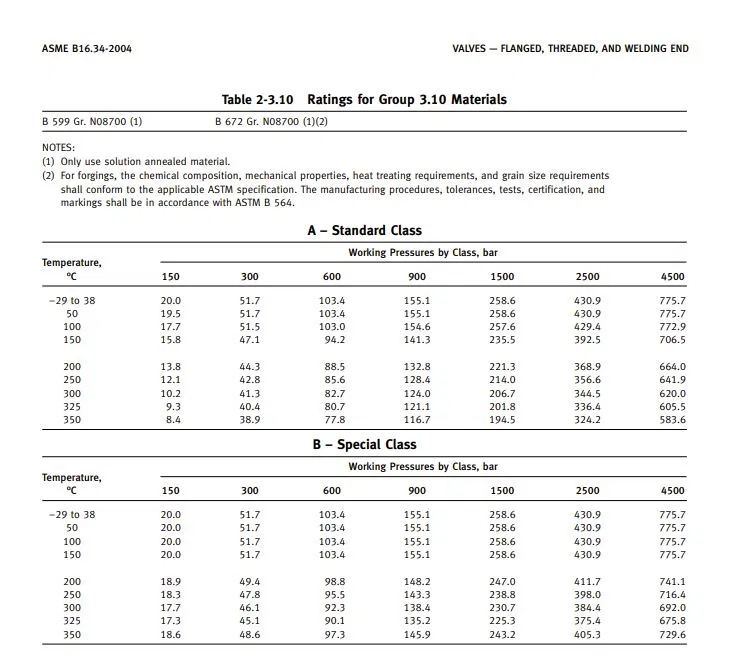
異なる圧力単位間で計算する方法?
マスターユニット変換は、正確な計算に不可欠です. ここに一般的なバルブ圧力変換があります:
- 1 MPA≈ 145 psi
- 1 バー≈ 14.5 psi
- 1 bar = 0.1 MPA
- 1 kgf/cm²≈ 0.98 バー≈ 14.2 psi
異なるバルブの圧力評価間を変換する方法?
これは重要でしばしば誤解されている概念です: PN評価とクラス評価の間に変換する直接的な数学的式はありません!
これは、それらが異なる標準システムに基づいているためです, 参照温度, および材料グループ. しかし, エンジニアリングアプリケーションの便利さ, 次の 近似通信チャート 参照できます. このチャートは参照用です; 正確な選択は、特定の標準に基づいている必要があります.
テーブル 1: バルブ圧力クラスVs. PN評価変換リファレンス
| クラス評価 | pn (公称圧力) |
|---|---|
| クラス 150 | pn 20 |
| クラス 300 | pn 50 |
| クラス 400 | pn 68 |
| クラス 600 | pn 110 |
| クラス 900 | pn 150 |
| クラス 1500 | pn 260 |
| クラス 2500 | pn 420 |
バルブ圧力の関係 (P-T) 評価
の バルブ圧力評価 バルブの選択において最も重要な概念です. 動作温度が上昇するにつれて、バルブの最大許容作業圧力が低下することを指示します.
ASME標準に続くすべてのバルブについて, 圧力定格はaによって定義されます バルブ圧力温度定格表. このチャート, バルブに基づいています 材料 (例えば。, 炭素鋼A216 WCB, ステンレス鋼A351 CF8M) そして クラス評価, さまざまな温度での最大許容作業圧力を詳述します.
例えば, クラス 150 炭素鋼バルブは近くで処理される場合があります 285 周囲温度でのpsi, しかし、温度が300°Cに上昇すると (572°F), その最大許容圧力は下に落ちる可能性があります 100 psi.
バルブの圧力評価に影響する重要な要因は何ですか?
- バルブボディ材料: これが決定的な要因です. さまざまな材料 (炭素鋼, ステンレス鋼, 合金鋼, 真鍮) さまざまな温度で大きく異なる機械的強度とクリープ抵抗を持っている.
- 動作温度: 前述のように, 温度は材料の強度に直接影響し、バルブの圧力処理機能を決定します.
- 設計標準: 違う バルブ圧力定格標準 ドキュメント (例えば。, ASME, API, から) 設計にはさまざまな要件があります, 材料, およびテスト.
- 接続タイプ: フランジュなどのさまざまな接続タイプの強度とシーリングパフォーマンス, 溶接された, または、ねじれ端はバルブの全体的な圧力定格に影響します.
- バルブタイプ: 異なるバルブの内部設計, aなど バルブの圧力定格を確認します 対ゲートバルブ, 圧力とシーリングの潜在的な弱点が異なることを意味します.
バルブ材料, 動作温度と圧力比較テーブル
| バルブ材料 | プレッシャー (pn) | 温度 | メディア |
|---|---|---|---|
| 灰色の鋳鉄 | ≤ 1.0 MPA | -10°C〜200°C | 水, スチーム, 空気, ガス, およびオイル製品. |
| 順応性のある鋳鉄 | ≤ 2.5 MPA | -30°C〜300°C | 水, スチーム, 空気, およびオイル製品. |
| 延性鉄 | ≤ 4.0 MPA | -30°C〜350°C | 水, スチーム, 空気, およびオイル製品. |
| 酸耐性高シリコン延性鉄 | ≤ 0.25 MPA | < 120℃ | 腐食性メディア. |
| 炭素鋼 | ≤ 32.0 MPA | -30°C〜425°C | 水, スチーム, 空気, 水素, アンモニア, 窒素, および石油製品. |
| 銅合金 | ≤ 2.5 MPA | -40°C〜250°C | 水, 海水, 酸素, 空気, オイル製品, と蒸気. |
| 高温銅 (合金) | ≤ 17.0 MPA | ≤570°C | 蒸気および石油製品. <br> 注記: 選択は、バルブの圧力温度標準に準拠する必要があります. |
| 極低温鋼 (低温鋼) | ≤ 6.4 MPA | ≥-196°C | エチレン, プロピレン, 液化天然ガス (lng), 液体窒素, 等. |
| ステンレス鋼 (酸耐性) | ≤ 6.4 MPA | ≤200°C | 硝酸, 酢酸, 等. |
適切なバルブの圧力定格を選択する方法
科学的で安全な選択プロセスについては、次の手順に従ってください:
- 動作条件を決定します: システムの最大作業圧力と最大動作温度を明確に定義します. これが選択の基盤です.
- バルブ素材を選択します: 液体の腐食性に基づいて、適切なボディとトリム材料を選択します, 温度, その他の要因.
- P-T評価チャートを参照してください: 選択した材料に対応するバルブの圧力定格表を見つけます.
- 安全マージンを確認して適用します: チャートに, 最大動作温度を見つけて、対応する最大許容圧力を見つけます. この圧力値があることを確認してください より大きい システムの最大作業圧力, 安全マージンを含めます (通常 10%-25% 推奨されます).
- 評価を完成させます: aを選択します バルブの圧力定格 そのP-T曲線は、動作点を完全にカバーします.
例: システムには最大作業圧があります 45 バー (約. 653 psi) 300°Cの最高温度 (572°F). 媒体は蒸気です, 材料はASTM A216 WCB炭素鋼です. ASME B16.34標準に相談することにより, あなたはそのクラスを見つけるでしょう 300 バルブの定格はおよそです 50 その温度でバー, 一方、クラス 150 バルブの評価ははるかに低いです. したがって, クラスを選択する必要があります 300 またはより高い圧力評価.
理想的なバルブソリューションを見つけてください – で最適化します bmag


